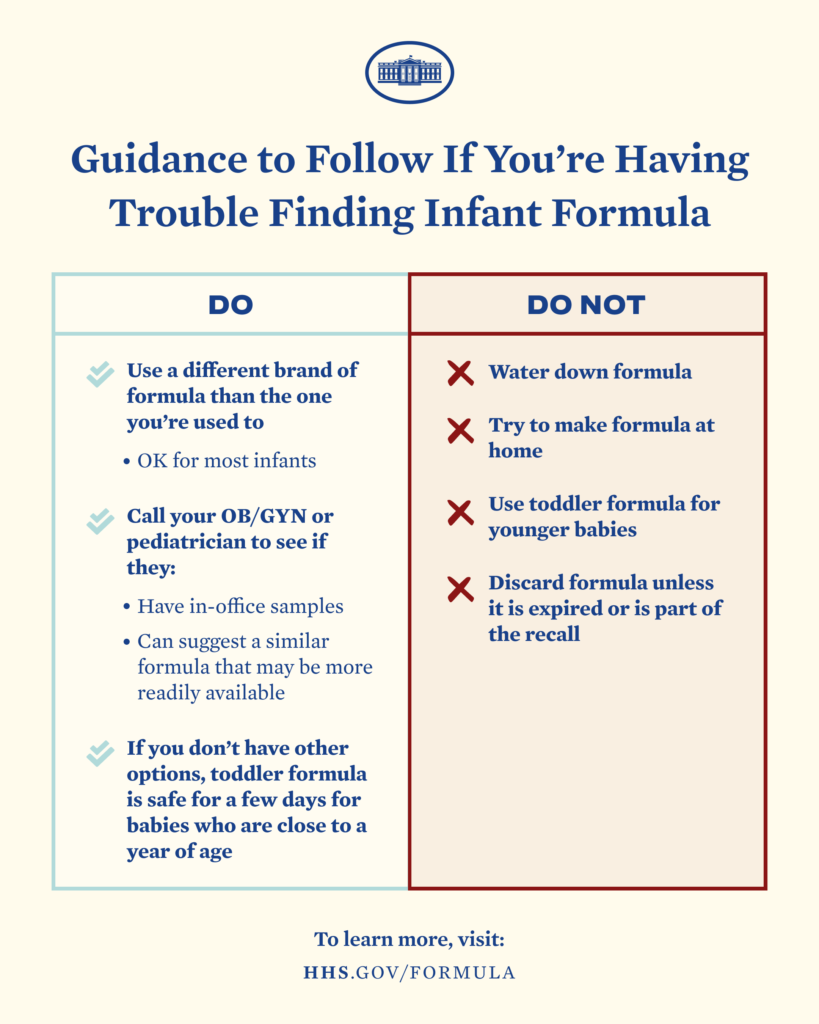

Approved by the What’s Up Moms Medical Advisory Board
To understand the scope of the current infant formula crisis, all you have to know is that three out of four babies in the US rely on formula during the first six months of their life. Of course, if you have a formula-fed baby at home right now, you know firsthand exactly how scary and panic-inducing this shortage is. We sat in on a White House briefing specifically about the formula situation – and also checked in with a pediatrician from the What’s Up Moms Medical Board. The news is shifting quickly but here’s the lay of the land.
How we got here:
Back in February, the Abbott plant in Michigan ceased production of baby formula after four infants who consumed its product were diagnosed with bacterial infections (the FDA is still investigating). The recall, along with global supply chain problems caused by the pandemic, dovetailed to create a serious lack of supply.
Complicating factors is the concentrated baby formula market. There are only four major infant formula manufacturers – Reckitt, Nestle/Gerber, Perrigo and Abbott. So when one plant ceased production, the waves were felt big time. Parents’ panic-buying in the ensuing months has exacerbated things. Now stores like Target and Walgreens are limiting the amount of formula an individual can buy.
The latest developments
The Biden administration, which has been criticized by some for not responding to the crisis earlier and with enough urgency, has in the past few days taken several concrete steps, including:
- adjusting the flexibility of the WIC (Women, Infants and Children) program, the supplemental nutrition program that helps support low-income women and their families. The new changes aim to help people have more flexibility within their program benefits so that more formulas/ packaging/ sizes are available to them.
- importing more formula from other countries (normally the US produces all but 2% of the infant formula it uses) and launching a program that will use U.S. military aircraft to import that formula from abroad.
- getting the Abbott plant back online; Abbot and the FDA struck a deal to resume formula production there.
- invoking the Defense Production Act, a 1950 law that forces the federal government to prioritize key ingredients for formula production. It also ensures that suppliers make it a priority to provide the resources formula manufacturers need, no matter what else is on their plate.
OK, so what can struggling parents do in the meantime?
The reality is there won’t be an overnight solution. Surgeon General Vivek Murthy predicted today that more supply will hit shelves in coming weeks. But reps at the Abbott plant say it could take two weeks just to get their production ramped up again, then several weeks after that for product to hit shelves.
Obviously parents need to know what to do right now. Read on for advice from Dr. Karen Hovav, a board-certified pediatrician in Los Angeles and Fellow of the American Academy of Pediatrics. She says:
Don’t…
- make your own formula. For one, the home is not a sterile environment. Also, DIY formulas can be harmful because they’re often lacking in essential nutrition, she says.
- don’t water down/ dilute the formula. This can lead to serious electrolyte disturbances — like low sodium levels — that can lead to seizures.
- use formula past the expiration date, as it loses nutrients and runs the risk of being contaminated with mold or bacteria.
- assume that your Similac formula is part of the Abbott recall, because it might not be! Check here to see if your formula’s lot number is part of the recall or not.
Do…
- consider switching formulas. Just because it’s different doesn’t mean it’s bad. Hovav says it’s OK to switch to store brand formulas if your baby is on a regular milk-based formula or a formula for sensitive tummies. “Most store brand formulas have an equivalent that is very similar, and most babies can adjust to switching brands with minimal side effects,” she says. “It might take them a few days to get used to it, but it’s perfectly safe to do.” Note that if your baby is on an extensively hydrolyzed formula (like Neocate or Enfacare) this won’t work, as there are no store-brand equivalents.
- tap your mom groups on social media and elsewhere. Several communities are DIYing databases for “formula matchmaking” of sorts in which moms can help each other by communicating about who has supply to share, who has specific kinds of formula, etc. Parents can also share information about which stores have what in stock.
- stock up on formula for about 10-14 days but not more. The AAP (American Academy of Pediatrics) discourages buying more than that to avoid worsening the shortage.
- use milk or toddler formula IF your baby is older. If your child is closer to a year (for example, 10 months or older) and you absolutely have no formula, it’s OK to use either a toddler’s formula or whole milk temporarily until you get new formula again, Hovav says. Note that if you’re offering whole milk, you should not offer more than 24 ounces per day. Also, since whole milk can decrease iron absorption, you’ll want to make sure you’re giving your baby plenty of iron-rich foods. She emphasized that this should be a temporary measure just used to fill the gap until formula is in hand again.
- feed more solids IF your baby is older. “I’ve had some parents ramp up solids to three meals per day earlier than they otherwise would because they’re hoping their baby will eat a little less formula and they can then stretch it out for longer.”
- sub preemie formula for a full-term infant temporarily.
- check out the Health and Human Services page, where information is being updated regularly. Meaning Full Living put together this great post with some excellent here-and-now things parents can do to get the product their babies need.







